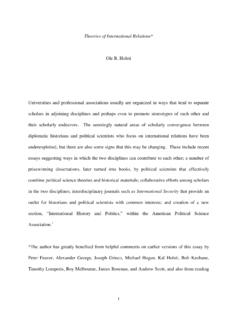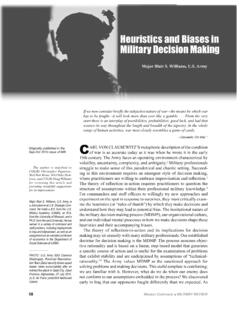Transcription of Developing Leaders in a VUCA Environment
1 By: Kirk Lawrence Program Director UNC Executive Development All Content UNC Executive Development 2013 Website: |Phone: |Email: Developing Leaders in a VUCA Environment Developing Leaders in a VUCA Environment All Content UNC Executive Development 2013 2 | P a g e Introduction n The World Is Flat, Thomas Friedman notes that the rate of change today is much different than in the past. Whenever civilization has gone through one of these disruptive, dislocating technical revolutions like Gutenberg s introduction of the printing press the whole world has changed in profound ways, he writes. But there is something different about the flattening of the world that is going to be qualitatively different from other such profound changes: the speed and breadth with which it is taking flattening process is happening at warp speed and directly or indirectly touching a lot more people on the planet at once.
2 The faster and broader this transition to a new era, the more likely is the potential of disruption. To put it another way, the experiences of high-tech companies in the last few decades who failed to navigate the rapid changes brought about in their marketplace by these types of forces may be a warning to all the businesses, institutions and nation states that are now facing these inevitable, even predictable, changes but lack the leadership, flexibility and imagination to adapt not because they are not smart or aware, but because the speed of change is simply overwhelming them. This rapid flattening, as Friedman calls it, is creating a new Environment that strategic business Leaders are increasingly calling a VUCA Environment . Coined in the late 1990 s, the military-derived acronym stands for the volatility, uncertainty, complexity, and ambiguity terms that reflect an increasingly unstable and rapidly changing business world.
3 This new VUCA Environment will require HR and talent management professionals to change the focus and methods of leadership development. This white paper: Discusses the history of VUCA and how it applies to business strategy and development. Explores how VUCA is relevant to leadership development. Discusses the VUCA Prime, which flips the acronym to focus on vision, understanding, clarity, and agility. Offers suggestions on what HR and talent managers must do to change their leadership development approach to foster leadership vision, understanding, clarity, and agility. I Developing Leaders in a VUCA Environment All Content UNC Executive Development 2013 3 | P a g e The Origins of VUCA he notion of VUCA was introduced by the Army War College to describe the more volatile, uncertain, complex, and ambiguous, multilateral world which resulted from the end of the Cold War (Kinsinger & Walch, 2012).
4 The acronym itself was not created until the late 1990s, and it was not until the terrorist attacks of September 11, 2001, that notion and acronym really took hold. VUCA was subsequently adopted by strategic business Leaders to describe the chaotic, turbulent, and rapidly changing business Environment that has become the new normal. By all accounts, the chaotic new normal in business is real. The financial crisis of 2008-2009, for example, rendered many business models obsolete, as organizations throughout the world were plunged into turbulent environments similar to those faced by the military. At the same time, rapid changes marched forward as technological developments like social media exploded, the world s population continued to simultaneously grow and age, and global disasters disrupted lives, economies, and businesses. VUCA and Leadership Development his new VUCA Environment , as Friedman notes, is taxing even the most able of Leaders who may find their skills growing obsolete as quickly as their organizations change in this volatile, unpredictable landscape.
5 Leadership agility and adaptability are now required skills if organizations are to succeed in this VUCA world. As Horney, Pasmore, and O Shea, authors of "Leadership Agility: A Business Imperative for a VUCA World" note, to succeed, Leaders must make continuous shifts in people, process, technology, and structure. This requires flexibility and quickness in decision making. (Horney, Pasmore, O Shea, 2010). (For additional insights on a new approach for Developing leadership agility, refer to the UNC Executive Development white paper: Leadership Agility: Using Improv to Build Critical Skills.) The Boston Consulting Group (BCG) concurs. A recent BCG study concluded that organizations today must shift their business models and their leadership skills to become adaptive firms. Adaptive firms can adjust and learn better, faster, and more economically than their peers, giving them an adaptive advantage. Adaptive firms, the study notes, include Apple, Google, 3M, Target, and Amazon.
6 T T Developing Leaders in a VUCA Environment All Content UNC Executive Development 2013 4 | P a g e A report by the Center for Creative Leadership (Petrie, 2011) also notes that today s VUCA business Environment requires Leaders to possess more complex and adaptive thinking abilities. It also notes that the methods used to develop these new skill requirements (like on-the-job training, coaching, and mentoring) have not changed much, and as a result, Leaders are not Developing fast enough or in the right ways to keep up with the new normal for business. HR and talent management professionals must position their organizations to succeed in today s turbulent business Environment by Developing agile Leaders . Applying the VUCA model as a framework to re-tool leadership development models may enable HR and talent management professionals to identify and foster the Leaders their organizations need now and in the future.
7 Company Spotlight: Unilever In 2010, Unilever, one of the world s largest consumer goods companies, pledged to double the size of their business in the next 10 years while reducing its environmental footprint and increasing its social impact. Sustainability became a central component of their new business model, one based on VUCA principles. When asked by Forbes contributor Avi Dan why they changed their business model, Keith Weed, chief marketing and communication officer for Unilever, responded: We look at the world through a lens, which we call VUCA, which stands for Volatile, Unstable, Complex, and Ambiguous. So you can say, It s a very tough world, or you can say, It s a world that s changing fast, and we can help consumers navigate through it. Two-and-a-half billion more people will be added to the planet between now and 2050, of which 2 billion will be added in Developing countries.
8 The digital revolution, the shift in consumer spending, all this suggests that companies have to reinvent the way they do business. (Dan, 2012.) To meet that VUCA challenge, Unilever has also changed its leadership development model. Source: Sullivan, 2012 January. Developing Leaders in a VUCA Environment All Content UNC Executive Development 2013 5 | P a g e VUCA Defined he V in the VUCA acronym stands for volatility. It means the nature, speed, volume, and magnitude of change that is not in a predictable pattern (Sullivan, 2012 January 16). Volatility is turbulence, a phenomenon that is occurring more frequently than in the past. The BCG study found that half of the most turbulent financial quarters during the past 30 years have occurred since 2002. The study also concluded that financial turbulence has increased in intensity and persists longer than in the past. (Sullivan, 2012 October 22). Other drivers of turbulence in business today include digitization, connectivity, trade liberalization, global competition, and business model innovation (Reeves & Love, 2012).
9 The U in the VUCA acronym stands for uncertainty, or the lack of predictability in issues and events (Kinsinger & Walch, 2012). These volatile times make it difficult for Leaders to use past issues and events as predictors of future outcomes, making forecasting extremely difficult and decision-making challenging (Sullivan, 2012 January 16). The C in VUCA stands for complexity. As HR thought leader John Sullivan notes (2012 January 16), there are often numerous and difficult-to-understand causes and mitigating factors (both inside and outside the organization) involved in a problem. This layer of complexity, added to the turbulence of change and the absence of past predictors, adds to the difficulty of decision making. It also leads to confusion, which can cause ambiguity, the last letter in the acronym. Ambiguity is the lack of clarity about the meaning of an event (Caron, 2009), or, as Sullivan writes, the causes and the who, what, where, how, and why behind the things that are happening (that) are unclear and hard to ascertain.
10 (2012 January 16). Col. Eric G. Kail defines ambiguity in the VUCA model as the inability to accurately conceptualize threats and opportunities before they become lethal. (Kail, 2010 December 3). A symptom of organizational ambiguity, according to Kail, is the frustration that results when compartmentalized accomplishments fail to add up to a comprehensive or enduring success. T Developing Leaders in a VUCA Environment All Content UNC Executive Development 2013 6 | P a g e The VUCA Prime he VUCA model identifies the internal and external conditions affecting organizations today. The VUCA Prime was developed by Bob Johansen, distinguished fellow at the Institute for the Future and the author of Leaders Make the Future: Ten New Leadership Skills for an Uncertain World. Johansen proposes that the best VUCA Leaders are characterized by vision, understanding, clarity, and agility - the flips to the VUCA model.






